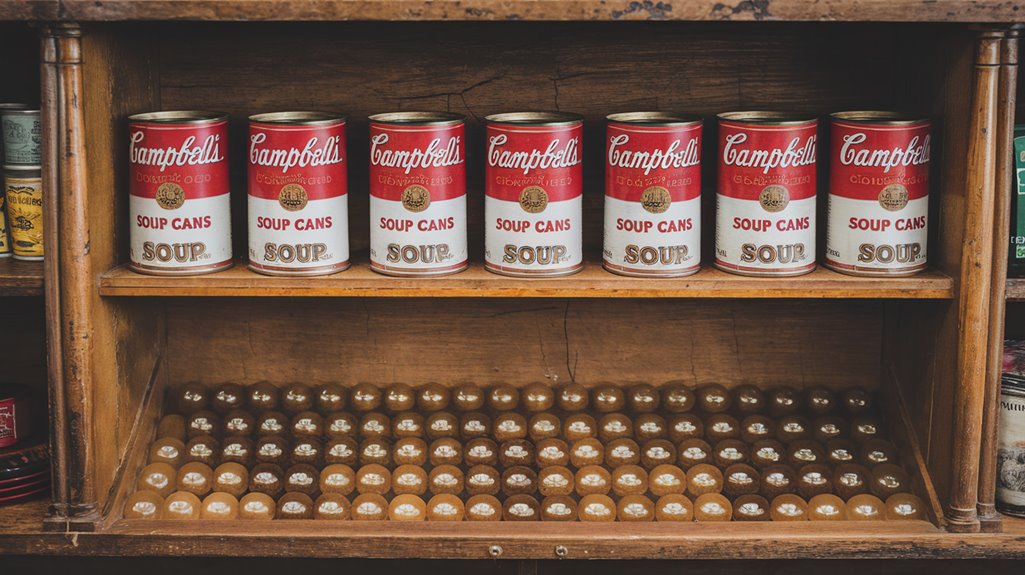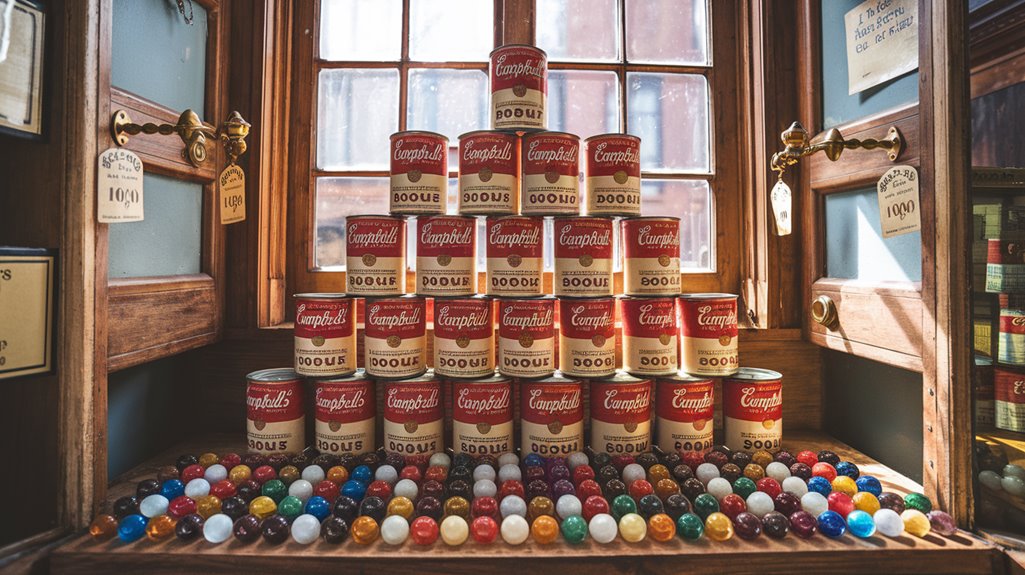Campbell’s Marbles: The Commercial Trick You Never Knew
When you see that perfect bowl of minestrone on your TV screen, with vegetables and pasta floating artfully throughout the broth, you're probably witnessing modern food styling techniques that evolved from a controversial 1960s practice. Back then, Campbell's Soup used clear glass marbles to prop up ingredients in their commercials, creating an illusion of abundance that wasn't quite honest. This clever but deceptive trick would eventually spark a revolution in advertising standards that affects how companies market their products today.
The Deceptive Soup That Changed Advertising

While food photography has become a sophisticated art form today, Campbell's Soup's controversial marble trick in the 1960s marked a turning point in advertising ethics.
You might be surprised to learn that the company placed marbles at the bottom of soup bowls to make ingredients float to the surface, creating an illusion of abundance.
When H.J. Heinz filed a complaint about this deceptive marketing practice, the FTC launched an investigation. Art director Robson Ballantine had used marbles to keep vegetables visible, which was standard practice at the time.
Campbell's defended their technique, claiming it actually helped show the soup's true ingredients better than letting them sink.
The FTC wasn't convinced and charged both Campbell's and their advertising agency, BBDO.
While they didn't order corrective advertising, this case revolutionized industry standards, leading to stricter regulations and more creative, honest approaches to food styling.
The company's dedication to marketing innovation began with their iconic red and white label in 1898, which would become one of the most recognizable food packages in history.
Behind the Scenes: Glass Marbles and Food Photography
Although Campbell's marble trick sparked controversy, it revealed a broader world of food styling techniques that photographers and advertisers had long kept under wraps.
Behind every appetizing commercial shot, you'll find carefully orchestrated food presentation methods that enhance visual appeal.
Professional food stylists employ various tricks to make dishes camera-ready. They'll place ingredients in shallow bowls for better visibility, spray meat with oil to create a fresh-cooked sheen, and add artificial condensation to glassware. Clear glass objects require lighting that comes through them for optimal results, creating indirect illumination. Photographers often use long focal lengths to minimize unwanted reflections when shooting glassware and maintain a clean, professional look.
When shooting beverages and clear containers, photographers use strategic lighting techniques, positioning natural light from the side or back while using reflectors to control shadows and highlights.
While these methods might seem deceptive, today's regulations guarantee advertisers maintain ethical standards, preventing practices like the infamous marble technique that misled consumers about product content.
Students Fight Back: The Birth of SOUP Movement
As food styling techniques became more widespread in advertising, a group of law students at George Washington University decided to take action.
In the 1970s, they formed Students Opposed to Unfair Practices (SOUP), targeting deceptive advertising tactics like Campbell's use of marbles in their soup commercials. Just like Jordan's act of giving soup to homeless man Harry, activism often starts with simple gestures of kindness.
This wave of student activism challenged the ethics of food advertising head-on. You might be surprised to learn that these law students didn't just complain – they demanded concrete changes. Similar to how small acts of kindness can create meaningful change, these students believed their efforts could transform the industry.
Their main argument? Companies like Campbell's should be required to run corrective advertisements to address their deceptive practices.
Their efforts weren't in vain. The SOUP movement's dedication to advertising ethics led to stricter regulations and industry changes, proving that organized consumer action could effectively combat misleading commercial practices.
Legal Battle: FTC Vs Campbell's Soup
When Heinz filed a complaint with the Federal Trade Commission about Campbell's marble-filled soup commercials, it sparked one of advertising's most significant legal battles.
The FTC's investigation revealed that Campbell's and their advertising agency BBDO had placed marbles in soup bowls to make ingredients appear more plentiful than they actually were.
You might think Campbell's would've backed down immediately, but they fought back. Their defense? Without marbles, the soup would look like pure liquid in commercials.
The FTC regulations weren't buying it, viewing the practice as deceptive advertising. While the case was ultimately dropped in 1972, it fundamentally changed advertising ethics forever. A consumer advocacy group called SOUP intervened in the case and was granted in forma pauperis status by the FTC.
Today, Campbell continues its expansion efforts as shown by their substantial compliance certification with the FTC for the Sovos Brands acquisition.
The controversy pushed the FTC to establish stronger oversight measures, including the power to require corrective advertising from companies caught misleading consumers.
Legacy and Modern Food Advertising Standards

The Campbell's marble controversy left an enduring mark on food advertising standards in America. You'll see its regulatory impact reflected in today's strict oversight of food marketing practices, where both the FTC and FDA work together to prevent deceptive advertising.
The advertising evolution since then has been significant. While the 1938 Federal Food, Drug, and Cosmetic Act laid the groundwork, you'll now find a complex system of both government regulation and industry self-policing. The Wheeler-Lea Act expanded federal oversight of advertising for FDA-regulated products, setting important precedents for modern marketing standards. Public health advocates have shown that 170 million children worldwide are affected by obesity or being overweight, making advertising regulation crucial.
The Children's Food and Beverage Advertising Initiative (CFBAI), launched in 2006, shows how far we've come – with 18 major companies voluntarily pledging to limit unhealthy food marketing to children.
Though critics argue for stronger federal oversight, today's $2 billion food marketing industry faces unprecedented scrutiny and standards that trace their roots back to that simple marble trick.










